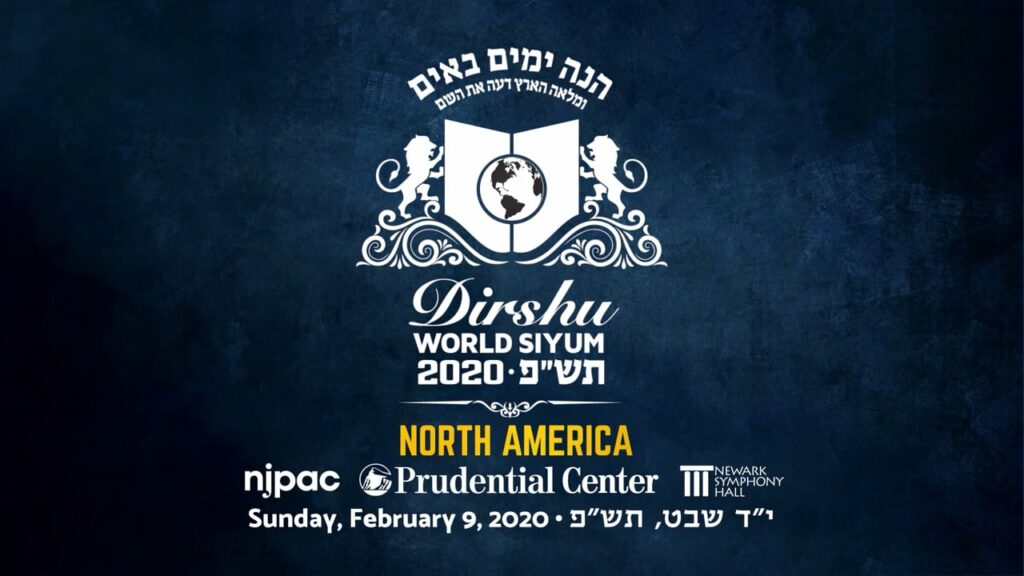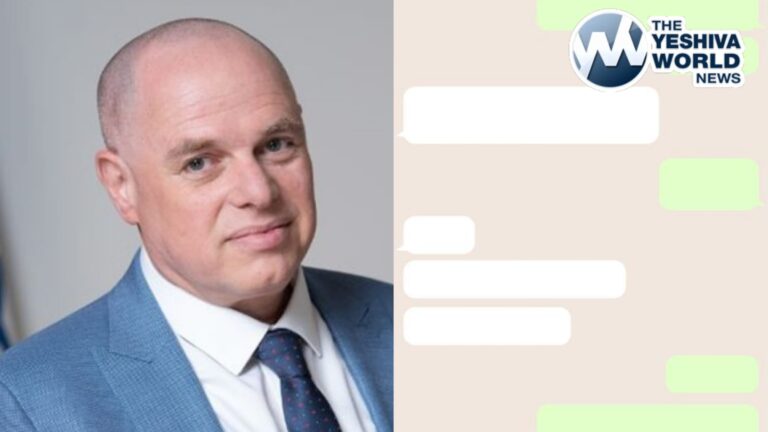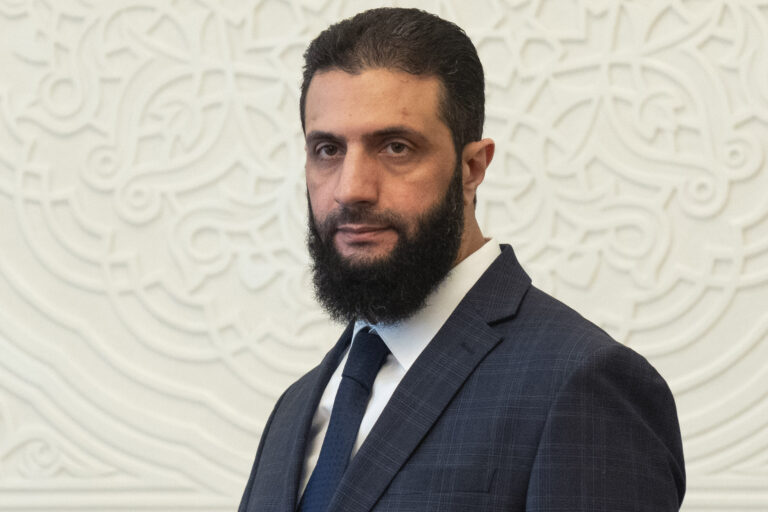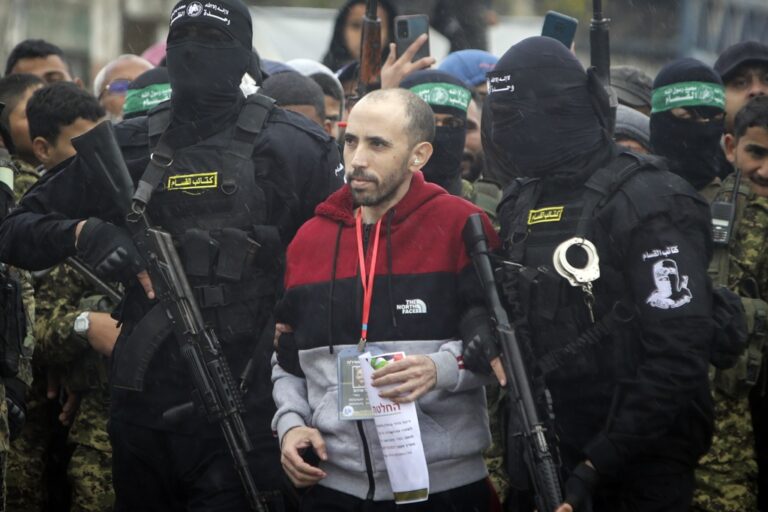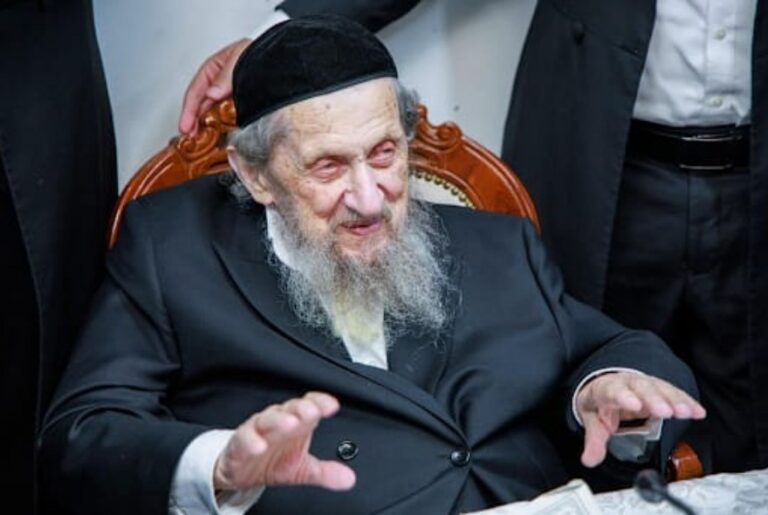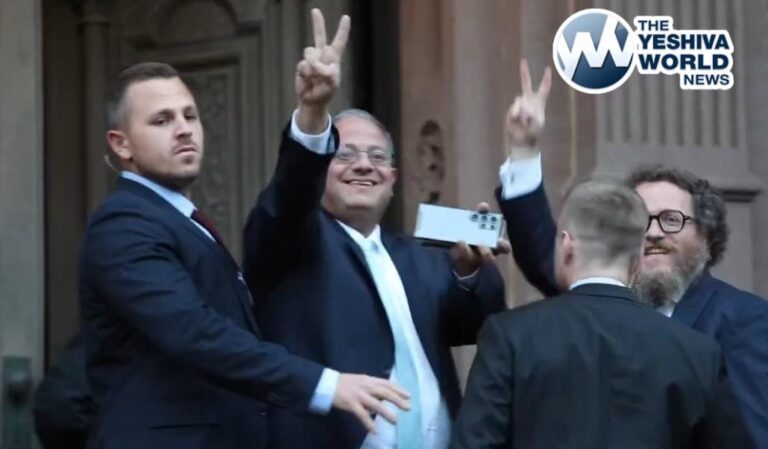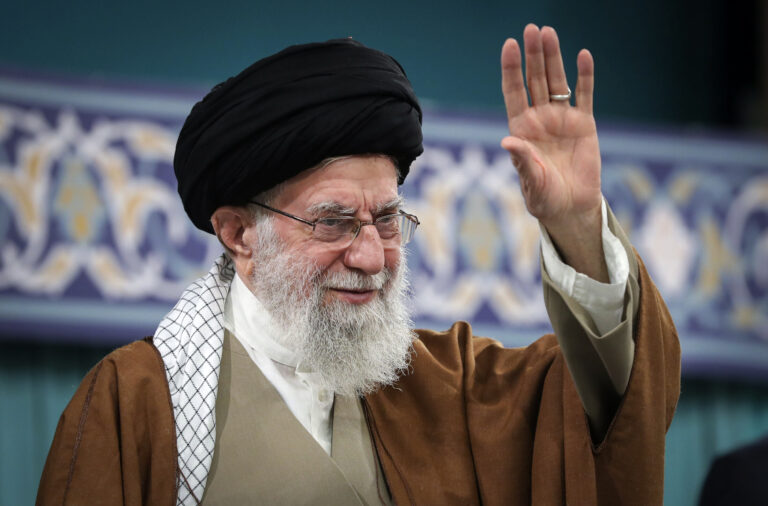By Rabbi Shmuel Kamenetzky
By no stretch of the imagination is Newark, New Jersey, the epicenter of the Torah world. Yet for one evening, the city of Newark hosted the most significant celebration of Torah accomplishments in the United States: The World Siyum of Dirshu.
The three venues, Prudential Center, NJPAC, and the Symphony Hall, held over 25,000 men, women, and children who traveled from all over the tristate area and beyond. They came to celebrate the accomplishments of thousands of Dirshu Yidden who not only finished Shas, but mastered it as well, reviewing it many times and passing monthly tests on each masechta that they learned.
As the streets surrounding the event venues slowly filled, one could feel the excitement in the air. Yidden swarmed toward the Prudential Center and NJPAC, waiting outside until the doors opened. There were many attendees besides for the mesaymim themselves.
“I didn’t finish Shas,” one guest from Brooklyn said. “But I came together with Klal Yisrael to celebrate this great accomplishment of learning and knowing Shas. I identify with Dirshu because when I learn, I too need to have a clarity in learning. In order for the Torah to make an impression on you, you must fully understand what you’re learning.”
Another participant from Williamsburg was mesayem Shas and came as a true ba’al simchah.
“This is my third time finishing Shas,” he said. “Dirshu has changed not only my life, but also the lives of my entire family. It’s impossible to describe the feelings of accomplishment tonight. I have taken the tests for seven years, and at a certain point, I felt that it was simply too much and I needed a break. As soon as I stopped my chazarah and the test, I felt that something was missing in my life. I simply could not be without the hischayvus! I immediately began the cycle of chazarah and tests again.”
As the huge arena slowly filled with thousands of ba’alei simchah, one could not help but notice how this venue was meticulously prepared for the event, each detail ensuring the proper kavod haTorah. Each seat was prepared with a bag of refreshments for the guests, with the signature Dirshu style, to ensure that they enjoy the program to its fullest.
The dais was graced by gedolei Yisrael from America and Eretz Yisrael. The main floor was set with tables for Rabbanim, Admorim, Roshei Yeshivah, Dayanim, Maggidei Shiur, and Dirshu participants. The center table was decorated with beautiful tablecloths and floral arrangements — a reflection of the kavod deserved by the leaders and heroes of Klal Yisrael.
Looking around the arena, it was obvious that the participants were not just observers. They were true ba’alei simchah, rejoicing in the true simchah of mastery of Shas.
As the program began with a beautiful niggun sung by Motti Steinmetz, the participants were inspired by his pure voice and heartfelt emotion. The musical arrangements throughout the night were nothing short of majestic. Both Hamenagnim and Freilich Orchestras, led by Moshe Roth and Avromi Schreiber and conducted by Reb Mona Rosenblum and Ruvi Bennet, were accompanied by Shira, Malchus, and Yiddishe Nachas choirs — all known for their unparalleled talent and execution. Their brilliant music was both uplifting and beautiful as they were accompanied by Motti Steinmetz, Isaac Honig, Zanvil Weinberger, Ahrele Samet, and Yisroel Adler, who sang heartfelt, uplifting niggunim throughout the four-hour program. Reb Mona Rosenblum composed a special niggun, “Bihisasef Roshei Am,” in honor of the Dirshu World Siyum, and it was performed at the end of the evening by Yisroel Adler.
The stage was set up with a dazzling display of lights and visuals on massive LED screens behind the stage. As soon as the music began, all 20,000 participants were completely enveloped in the music, uplifting all their senses with niggunim of simchah and hisorrerus.
Ma’ariv was led by Reb Avrohom Bleeman, the father in law of Dirshu’s Nasi, Rav Dovid Hofstedter and a holocaust survivor, followed by HaRav Zev Smith, Maggid Shiur Dirshu Daf HaYomi B’Halacha and Maggid Shiur Irgun Shiurei Torah, who opened the siyum and set the tone for the evening.
“Was there ever a generation where it was so easy to learn?” he asked. “This is the dor of pischu li pesach shel ulam! Dirshu is making it easy to live ki heim chayeinu, and Dirshu is enabling Klal Yisrael to be mekayem ‘Ashrei mi sheba l’kan v’talmudo b’yado!’”
He explained that Dirshu defies the problem of “reichayim betzavaro v’yaasok baTorah!” Dirshu participants proved that even though they are busy earning a livelihood, they can still be amal baTorah. He then continued to encourage everyone present to make a kabbalah in learning and to put in more effort to learn and review.
HaRav Shimon Galei, shlita, noted mekubal from Eretz Yisrael, led the attendees in Tehillim, and he then addressed the crowd. He began by praising Dirshu for making this Yom Tov. He spoke about how when Moshe Rabbeinu turned to the burning bush, Hashem saw that he turned, and explained what he was seeing.
“Lomdei Dirshu are zocheh to the same siyata d’Shmaya! When one wants to learn Shas and purify himself, he is a ‘sar liros’ and Hashem gives him what he needs to understand!”
Rav Shmuel Aron Tousig, shlita, mashgiach ruchani in Yeshiva Alexander in Bnei Brak, spoke passionately about Dirshu and the accomplishments of the participants. One could hear the fire in his voice as he emotionally gave over his feelings on the importance of ameilus baTorah, and the responsibility of ameilus that Dirshu created.
“This is the dream of Rav Meir Shapiro,” he explained. “So many mesaymim who understand their learning gather tonight — what a holy night!
“At Mattan Torah, the malachim rejoiced. Imagine what type of simchah there is in Shamayim right now — with the Tanna’im and Amora’im all rejoicing with the Torah being learned.”
The crowd was then treated to a beautiful rendition of “Hadran Alach” by Isaac Honig, who was accompanied by a choir, followed by a melody sung by Ahrele Samet.
One of the highlights of the siyum was the drashah by Rav Dovid Cohen, shlita, Rosh Yeshivas Chevron. Rav Dovid had made a rare trip to America in honor of the siyum, and his drashah was highly anticipated. When he was introduced to the crowd, a rousing rendition of “Yamim Al Yemei Melech” broke out, showing how excited the attendees were by his participation.
Rav Cohen said over a Midrash, in which Klal Yisrael asks the Ribono Shel Olam how we will survive in galus. The Ribono Shel Olam answers, “Ruchi asher alecha” — the Torah is what will enable Klal Yisrael to survive. Until we are finally zocheh to u’va l’Tzion goel, we must hold onto the Torah to keep us going. He repeated a phenomenal thought from Rav Hutner, zt”l. When one makes a siyum on Shas, he is not merely completing 60 masechtos; he is making a siyum on the entire Torah sheb’al peh! This siyum is a true simchas haTorah because the mesaymim learned, reviewed, and mastered the entire Torah sheb’al peh — and this is true simchas haTorah!
Rav Leibish Lish introduced HaRav Yerucham Olshin, shlita, Rosh Yeshivas Beis Medrash Govoha. Rav Yerucham repeated a Midrash that says Yaakov Avinu did not just learn during his years in the yeshiva of Shem. He was “mevarer talmudo” — he reviewed and perfected his learning. This was the type of learning that would protect him from his galus in the house of Lavan. He then explained that in our galus, too, the type of learning that will save and redeem us is the Dirshu learning — perfecting and reviewing Shas!
He then took a moment to thank the wives of Dirshu for their support of their husbands, thus enabling them to continue their holy mission of ameilus baTorah!
Rav Leibish Lish mentioned that on that very morning, he had met a boy wearing a white shirt. When he asked the boy why he was wearing a white shirt, the boy responded, “My father does Dirshu, so I’m going to the siyum.” Rav Lish then corrected the boy and repeated his comment to the crowd with great excitement: “Dirshu is not what we do! Dirshu is what we are!” The crowd broke out in applause, expressing their appreciation of these words — and of this movement that changed their lives.
The Sanzer Rebbe from Eretz Yisrael, shlita, addressed the crowd in a soft-spoken voice. He excused himself for speaking even though he is not truly worthy. He then spoke about the vision of his father, the previous Klausenberger Rebbe, to create Mifal Hashas, a movement to promote chazarah of Daf Yomi followed by a monthly test.
“When he first thought of the idea, the Roshei Yeshiva told him that there may be 100-180 yungeleit in Eretz Yisrael who will join, but 1,000 came to the first test!
“Dirshu is a continuation of my father’s work!” he exclaimed. “Learning and understanding must go together. Dirshu makes a difference to lives, and Dirshu makes a difference to the entire Klal Yisrael! Dirshu has the unique ability to gather Yidden from all parts of Klal Yisrael and encourage everyone to learn.”
Rav Reuven Feinstein, shlita, was honored with saying the Hadran, and Rav Malkiel Kotler, shlita, said Kaddish. The crowd then broke out in exuberant dancing. To many, this was the highlight of the night, as they were all able to express the true joy of simchas haTorah through true ameilus, which built up inside their hearts over the past seven years.
Rav Lish then said that when a group came to Rav Wosner, zt”l, to get his haskamah on Dirshu, he responded, “Why do you need my haskamah? It’s obvious that the Ribono Shel Olam Himself gives a haskamah! He ensures that everything Dirshu does is successful! These are the beautiful fruits of Dirshu…”
He then introduced the Nasi of Dirshu, Rav Dovid Hofstedter.
Rav Dovid began by commending the thousands of new participants in the Dirshu program. “We just had the first bechinah this past Thursday night,” he said. “And there were several tens of thousands of new people who took the tests!”
He said that tonight, Tu B’Shevat, is a big hischazkus — not only in peiros of gashmiyus but also in peiros of ruchniyus. When the water in Marah was bitter for the Yidden, it wasn’t the water that was bitter; they themselves were bitter. They didn’t appreciate the Torah. Only when Moshe Rabbeinu threw in a bitter tree — with arduous amal and yegiah — did the waters of Torah become sweet.
This is the derech of Torah sheb’al peh. When one begins his journey of ameilus, it is bitter. But as he continues his toil and work, the Torah becomes truly sweet.
“Today we have so many tools to clarify the Torah,” Rav Dovid said. “Many of these tools may dilute the tachlis — ameilus and yegiah, and carrying the ol of the Torah. To use these tools to make our lives easier, we will not succeed in transforming ourselves to taste those sweet waters of Torah.
“We sometimes think we are too tired, too busy, or simply not smart enough to learn. But we can! When it comes with a kabbalah of yegias haTorah and a kabbalas haTorah, we have to ask ourselves, ‘Are we going to be complacent with superficiality and superficial Torah of bitter waters, or will we experience sweet waters?’
“We must cry the battle cry of mi la’Hashem elai! The battle cry of Dirshu Hashem ve’uzo!”
After Rav Dovid’s drashah, Zanvil Weinberger performed a beautiful, heartfelt rendition of “Anu Ameilim V’heim Ameilim.” As Zanvil and the accompanying choir sang about our toil in Torah, everyone in the packed arena was uplifted.
The Vizhnitzer Rebbe, shlita, led the participants in kabbalas ol malchus Shamayim, followed by a drashah from HaRav Elya Ber Wachtfogel, shlita, Rosh Yeshivas South Fallsburg.
He quoted a Midrash that tells of a fool and a wise person who saw a loaf of bread on top of a mountain. The fool looked at it and despaired from ever reaching it. But the wise man said, “If it’s up there, it means someone must have put it there, and I too can reach the top.”
If you start from the beginning, it only gets easier. If you learn Brachos and then Shabbos, Eruvin will not be so hard. In the end a person will find himself learning in one hour what he couldn’t learn in a whole year when he first started!
A highlight of the evening was the featured audiovisual production, “Hinei yamim ba’im,” a historic perspective of a father and son in the early 1900s. The 10-year-old boy, Srulik, goes with his father to the Kenesia Gedola in Vienna, where they hear the Chofetz Chaim, in a weak voice, cry out to the Jews of the world, “Torah is our pulse! To stay alive, both as a Yid and as a nation of Klal Yisrael, we must learn Torah.”
To act upon that inspiration, the father and son immediately go to the beis medrash and learn together. The father takes a page from his grandfather’s Gemara and hands it to Srulik, telling him, “Torah is your pulse! This blatt Gemara will protect you.”
World War II breaks out, and Srulik survives. He wanders from camp to camp and then from town to town until he finally settles down — all the while, keeping his treasured blatt Gemara with him. Many years later, Srulik joins his grandson in celebration of his siyum haShas. In an emotion-filled moment, Srulik hands his treasured page to his einikel and tells him, “My father gave me this blatt from his zeide’s Gemara, telling me to protect it. But in reality, the blatt Gemara has protected me!
As the crowd left, visibly uplifted, one needed only to look around at their faces. The inspiration of the evening has surely changed all who attended. Many will soon join the ranks of our generation’s ameilim baTorah, and many will strengthen their commitment. But one message which everyone has taken home, is that Dirshu is no longer an organization, but a sweeping movement that is providing a solid foundation to support Klal Yisrael through the final stretch of our galus, and uplifting our entire nation – uniting Jews across the world with true Torah learning, and bringing them closer to Hashem.

